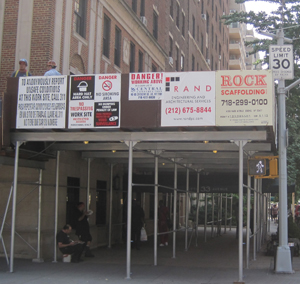
Sidewalk sheds are required when a building is undergoing facade repairs.
According to the Department of Buildings, there are more than 8,500 sidewalk sheds and scaffolds throughout New York City. If an article in Sunday's New York Post is any indication, there are also at least that many gripes about them. Among the common complaints: The sheds are an eyesore, they drive away business from stores, they harbor crime and other nefarious activities, they make it difficult to navigate the city's already crowded sidewalks, and they stay up seemingly forever. (The Post reports sidewalk sheds at the Milford Plaza Hotel near Times Square have been up for 23 years!)
Yet, as much as a nuisance as the sheds can be, they are also a necessity for public safety. The proliferation of sidewalk sheds is an outgrowth of the city's original facade inspection law, Local Law 10/80, which was enacted after a Barnard College freshman, Grace Gold, was killed in 1979 when a brick fell off the facade of a Morningside Heights building. The law requires all New York City buildings taller than six stories to be inspected every five years by a Licensed Engineer or Registered Architect to verify there are no unsafe conditions on the building's exterior walls. A sidewalk shed must be in place once a building is filed as unsafe and/or whenever significant repairs are being made to the facade.
Local Law 11/98 amended the original facade inspection law by requiring hands-on inspection from a scaffold along at least one representative facade, and requiring all of the building's facades higher than six stories to be inspected, not just street-facing ones. Local Law 11/98 is now known as the Facade Inspection & Safety Program, or FISP.
As RAND President Stephen Varone, AIA points out in the Post article, the city will be seeing even more sidewalk sheds going up this year. The final filing deadline for the 7th Cycle of facade inspections was last month, which means many more repair and maintenance programs will soon be underway. More sidewalk sheds will no doubt add to the frustration of businesses owners whose storefronts are obscured by the steel-and-plywood structures and pedestrians forced to squeeze their way through the often dark and dingy passageways.
But while much of the grumbling about sidewalk sheds is legitimate, some of it could be alleviated by following basic safety and maintenance measures. Sheds should be properly lighted, with unobstructed pedestrian access, and with clearly visible signage for stores and permit holders. Most of all, sidewalk sheds and scaffolding are supposed to be temporary structures while a building is under repair. They are not a permanent solution for indefinite postponement of necessary work.
As for the sidewalk shed's drab and dreary look, there may be hope on that horizon as well. The Urban Umbrella is a prototype sidewalk shed featuring a sleek, airy design that uses recycled steel columns with splayed spokes, translucent plastic panels, and LED lighting while still providing structural safety. The aesthetically pleasing design won the UrbanSHED Competition sponsored by the DOB and the American Institute of Architects in 2010, but aside from a brief trial installation at 100 Broadway, it has not yet been erected anywhere else. The chief objection is cost, in particular the labor costs associated with installation, with estimates of up to four times higher than for traditional installations.
Until an affordable version of the Urban Umbrella is devised, New Yorkers will have to put up with sidewalk sheds as an annoying but necessary part of life in the city. Safety first, and hopefully style will follow.
For more on sidewalk sheds, see RAND's Ask the Engineer column, and let us know your thoughts on the topic.
